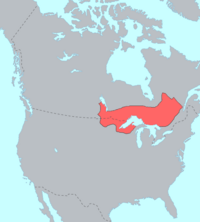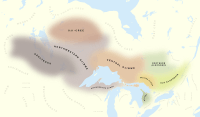Ojibwe language facts for kids
Quick facts for kids Ojibwe |
||||
|---|---|---|---|---|
| Ojibwa Anishinaabemowin, ᐊᓂᐦᔑᓈᐯᒧᐎᓐ |
||||
 |
||||
| Pronunciation | IPA: [anɪːʃɪnaːpeːmowɪn] | |||
| Native to | Canada, United States | |||
| Region | Canada: Quebec, Ontario, Manitoba, Saskatchewan, groups in Alberta, British Columbia; United States: Michigan, Wisconsin, Minnesota, groups in North Dakota, Montana | |||
| Ethnicity | Ojibwe people | |||
| Native speakers | (50,000 cited 1990–2016 censuses)e24 | |||
| Language family |
Algic
|
|||
| Dialects | (see Ojibwe dialects) | |||
| Writing system | Latin (various alphabets in Canada and the United States), Ojibwe syllabics in Canada, Great Lakes Algonquian syllabics in the United States |
|||
| Linguasphere | 62-ADA-d (Ojibwa+Anissinapek) | |||
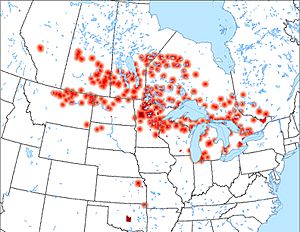
Location of all Anishinaabe Reservations/Reserves and cities with an Anishinaabe population in North America, with diffusion rings about communities speaking Anishinaabe languages.
|
||||
|
||||
Ojibwe (pronounced oh-JIB-way), also known as Ojibwa or Anishinaabemowin, is an important Native American language spoken in North America. It belongs to the Algonquian language family. This language is special because it has many different dialects. Each dialect often has its own local name and ways of writing.
There isn't one "main" dialect or a single standard way to write Ojibwe. People speak Ojibwe in Canada, across Quebec, Ontario, Manitoba, and parts of Saskatchewan. You can also find speakers in the United States, from Michigan to Wisconsin and Minnesota. Some communities are in North Dakota and Montana. There are even groups who moved to Kansas and Oklahoma a long time ago.
Ojibwe is the second most spoken First Nations language in Canada, after Cree. It's also one of the most widely spoken Native American languages in North America. The language is still quite strong today. For example, the Waadookodaading Ojibwe Language Immersion School teaches all subjects to children only in Ojibwe.
Contents
- Language Family and Names
- Where Ojibwe is Spoken
- Ojibwe Sounds (Phonology)
- Ojibwe Grammar Basics
- Ojibwe Words and Phrases
- How Ojibwe is Written
- People Who Speak Ojibwe
- Learning Ojibwe: Apps and Online Tools
- Past Challenges for the Ojibwe Language
- Bringing the Language Back to Life
- Ojibwe Language Immersion Schools
- Images for kids
- See also
Language Family and Names
Ojibwe is part of the larger Algonquian language family. This family is a branch of the even bigger Algic language family. Other Algic languages include Wiyot and Yurok.
Different Names for Ojibwe
The most common name for the language among its own speakers is Anishinaabemowin. This means "speaking the native language." It comes from Anishinaabe, which means "native person."
Some speakers use the term Ojibwemowin. In the Oji-Cree dialect, the language is called Anihshininiimowin. Speakers of Saulteaux Ojibwe might call their language Nakawemowin. The Ottawa dialect is sometimes called Daawaamwin. In English, the language is known as Ojibwe, Ojibwa, or Ojibway. The name Chippewa is often used in the United States.
Where Ojibwe is Spoken
Ojibwe communities are found across a wide area. In Canada, they are in southwestern Quebec, throughout Ontario, southern Manitoba, and parts of southern Saskatchewan. In the United States, they are in northern Michigan, northern Wisconsin, and northern Minnesota. There are also communities in northern North Dakota and northern Montana. Some speakers of the Ottawa dialect moved to Kansas and Oklahoma in the past.
Recent information shows that about 56,531 people speak different kinds of Ojibwe. This includes about 8,791 speakers in the United States and 47,740 in Canada. This makes Ojibwe one of the largest Native American languages by the number of people who speak it.
| Language | Canada (2016) | Canada (2011) | United States | Total (by speakers) | Total ethnic population |
|---|---|---|---|---|---|
| Algonquin | 1,660 | 2,680 | 0 | 2,680 | 8,266 |
| Oji-Cree | 13,630 | 12,600 | 0 | 12,600 | 12,600 |
| Ojibwe | 20,470 | 24,896 | 8,355 | 33,251 | 219,711 |
| Ottawa | 165 | 7,564 | 436 | 8,000 | 60,000 |
| Total (by Country) | 35,925 | 47,740 | 8,791 | 56,531 | 300,577 |
The Red Lake Indian Reservation, White Earth Indian Reservation, and Leech Lake reservations are known for singing hymns in the Ojibwe language. In 2011, Ojibwe became the official language of Red Lake.
Ojibwe Dialects and Their Differences
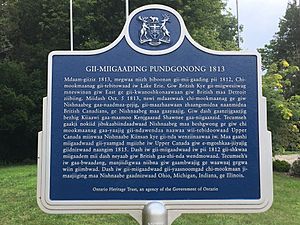
Even though there are many dialects, Ojibwe is usually seen as one language. This is because people speaking different dialects can often understand each other, especially if the dialects are spoken in nearby areas. It's like a "dialect chain" where each one is similar to its neighbor.
However, some dialects are quite different. For example, the Ottawa dialect (spoken in southern Ontario and northern Michigan) is very different from the Severn Ojibwe dialect (northern Ontario and Manitoba) and the Algonquin dialect (southwestern Quebec). These differences are likely because these groups were more isolated from each other.
Some of the main dialects, from west to east, include:
- Western Ojibwe (Saulteaux)
- Southwestern Ojibwe (Chippewa)
- Northwestern Ojibwe
- Severn Ojibwe (Oji-Cree)
- Ottawa (Odawa)
- Eastern Ojibwe
- Algonquin
Ojibwe as a Trade Language
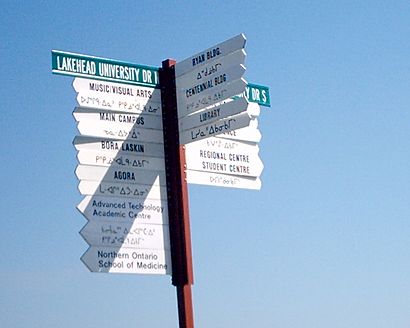
Historically, different Ojibwe dialects were used as lingua franca or trade languages. This means they were used for communication between people who spoke different languages, especially around the Great Lakes area. This use dates back to the 1700s and 1800s. People reported that Ojibwe was used from the Gulf of Saint Lawrence all the way to Lake Winnipeg.
A trade language helps different groups talk to each other, even if it's not their main language. Many people would learn some Ojibwe to trade or interact. For example, speakers of Potawatomi or Menominee (other Algonquian languages) often learned Ojibwe. Even speakers of non-Algonquian languages like Ho-Chunk (Winnebago) used Ojibwe when dealing with Europeans and other tribes.
How Ojibwe Influenced Other Languages
Ojibwe has also influenced other languages:
- Michif: This is a mixed language based on French and Plains Cree. It has some words from Ojibwe, especially in areas where Ojibwe was spoken a lot.
- Menominee: This related Algonquian language has borrowed some words from Ojibwe.
- Bungi Creole: This English-based language, spoken in Manitoba, has elements of Cree. Its name might come from the Ojibwe word bangii, meaning "a little bit."
Ojibwe Sounds (Phonology)
Ojibwe has a specific set of sounds, like all languages. It generally has 17 consonant sounds. Most dialects have a sound called a glottal stop (like the break in "uh-oh"). Some dialects, like Severn Ojibwe and Algonquin, use an "h" sound instead.
Ojibwe also has seven oral vowels. The length of a vowel is important in Ojibwe. This means that a long "a" sound is different from a short "a" sound. These vowel lengths affect how words are stressed and how some sounds change.
Words in Ojibwe usually have a main stress on a specific syllable. This is often on the third-to-last syllable. In some dialects, unstressed vowels at the beginning of a word can disappear.
Ojibwe Grammar Basics
Ojibwe grammar is similar across its dialects. It's a polysynthetic language, which means words can be very long. They are built by adding many small parts (like prefixes and suffixes) to a main word. These parts carry a lot of meaning.
The main word types are nouns, verbs, and small words called grammatical particles. In a simple sentence, the verb often comes first.
Ojibwe grammar has some interesting features:
- Animate and Inanimate: Nouns are divided into two groups: living things (animate) and non-living things (inanimate).
- Person and Number: Verbs change based on who is doing the action (I, you, he/she) and how many people are involved (singular or plural).
- Proximate and Obviative: This is a special feature for third-person nouns. If you're talking about two "he/she" people, one is the main focus (proximate), and the other is less important (obviative).
- Orders: Verbs have different "orders" depending on how they are used. For example, the indicative order is for regular statements, the conjunct order is for describing things or in certain types of sentences, and the imperative order is for commands.
Ojibwe Words and Phrases
Ojibwe is unique because it doesn't borrow many words from other languages. Instead, speakers often create new words for new ideas using words they already have. For example, "airplane" in Minnesota Ojibwe is bemisemagak, which literally means "thing that flies." "Battery" is ishkode-makakoons, meaning "little fire-box."
This means that new words can be different from one region to another. For instance, "airplane" in Northwest Ontario Ojibwe is ombaasijigan, meaning "device that gets uplifted by the wind."
Sometimes, words that used to mean the same thing now have different meanings in different dialects. For example, zhooniyaans means "dime" (10 cents) in the United States but "quarter" (25 cents) in Canada.
Common Ojibwe Words
Here are some examples of common Ojibwe words:
- onjibaa = he/she comes
- izhaa = he/she goes
- bakade = he/she is hungry
- ojibwemo = he/she speaks Ojibwe
- wiisini = he/she is eating
- bimose = he/she walks
- giiwe = he/she goes home
- nibaa = he/she sleeps
- ikwe = woman
- inini = man
- ikwezens = girl
- gwiiwizens = boy
- mitig = tree
- giigoonh = fish
- wiigiwaam = wigwam, house
How Ojibwe is Written
There isn't one official way to write all Ojibwe dialects. Different communities have created their own ways of writing using the Latin script (like the English alphabet).
Some Ojibwe speakers in northern Ontario and Manitoba use a special writing system called syllabics. In this system, each symbol stands for a whole syllable (like "ba" or "bi"), not just a single letter. This syllabic system was first developed for the Cree language.
The Double Vowel System
A popular way to write Ojibwe using Roman letters is the double vowel system. Many teachers use it because it's easy to learn. In this system, long vowels are written by doubling the vowel letter (like aa, ii, oo). Short vowels are written with a single letter (like a, i, o).
People Who Speak Ojibwe
Many important people have spoken or worked with the Ojibwe language:
- Frederic Baraga: A priest who wrote an Ojibwe grammar book in the 1800s.
- George Copway: A chief, missionary, and writer.
- Basil H. Johnston: An educator and writer who shared Ojibwe culture.
- Maude "Naawakamigookwe" Kegg: A storyteller and artist.
- Margaret Noodin: An educator and writer.
- Anton Treuer: A historian and professor, one of the first Ojibwe people to graduate from Princeton University.
- Archie Mosay: A medicine man and elder who mentored Anton Treuer.
Learning Ojibwe: Apps and Online Tools
You can find an "Ojibway Language and People" app for iPhone and iPad. This app helps people learn the language.
The Ojibwe People's Dictionary is a great online resource. It was made with the University of Minnesota. You can search for words in English or Ojibwe, and it even has voice recordings for many of its 17,000 entries.
Past Challenges for the Ojibwe Language
In the late 1800s, the United States government started Native American boarding schools. The goal was to force Native American children to adopt American culture. Children were often sent far from home. They were made to speak only English, cut their hair, wear uniforms, and learn European history.
This program continued into the 1960s and 1970s. Because children were away from their families, many didn't get to hear or use their native language. This caused a big loss of language and culture in many Native American communities, including the Ojibwe.
Bringing the Language Back to Life
Today, many older Ojibwe speakers are passing away. This means that the language is at a critical point. Experts like historian Anton Treuer estimate there are only about 1,000 Ojibwe speakers left in the United States. Most fluent speakers are over 70 years old.
To save the language, Ojibwe educators and scholars are working with these elders, called "First Speakers." They are recording stories and conversations to document the language. Anton Treuer, for example, records stories told by about 50 different Ojibwe elders. He then writes them down in both Ojibwe and English.
There's a growing effort to bring Ojibwe back into everyday use. Universities offer language classes for adults and young adults. There are also online games and resources for all ages. In the 1980s, a program in Ontario started teaching Indigenous languages like Ojibwe in schools. More children's books are also being published in Ojibwe.
Studies show that learning Indigenous languages in school helps with language structure. However, being surrounded by the language at home and with family is the most effective way to keep it alive.
Learning and using the Ojibwe language is also important for the well-being of the community. Research shows that people who regularly practice their language and culture often have better health, especially mental health.
Ojibwe Language Immersion Schools
Despite the past challenges from government policies, many Indigenous communities are now using schools to help bring the Ojibwe language back. They are inspired by successful language immersion schools for Polynesian languages in Hawaii and New Zealand.
One well-known school is the Waadookodaading Ojibwe Language Immersion School. It's located on the Lac Courte Orielles Reservation in Wisconsin. Most students here come from English-speaking homes and learn Ojibwe as a second language.
At this school, teachers and elders teach preschoolers to third graders entirely in Ojibwe. By kindergarten, students know both English and Ojibwe alphabets. They learn subjects like math, reading, and social studies through Ojibwe. This helps them hear and use the language a lot.
A challenge for these schools is creating new Ojibwe words for modern concepts, like "plastic" or "quotient." Since Ojibwe was traditionally an oral language, finding written resources can be hard. The language is always growing and changing to fit new needs.
Waadookodaading also uses traditional Ojibwe teaching methods. Ojibwe is a "language of action." Students learn by watching and doing. For example, during the maple sugar harvest, older students and elders teach younger ones. They describe everything in Ojibwe as the younger students help gather wood and sap. This hands-on learning helps keep the language alive.
Another great program is the Niigaane Ojibwemowin Language Immersion School on the Leech Lake Indian Reservation in Minnesota. Here, each classroom has an elder who speaks Ojibwe fluently, along with a trained teacher. Children learn school subjects and traditional skills like maple sugar harvesting and archery.
Images for kids
Template:KIDDLE XL START
See also
 In Spanish: Idioma ojibwa para niños Template:KIDDLE XL END
In Spanish: Idioma ojibwa para niños Template:KIDDLE XL END


